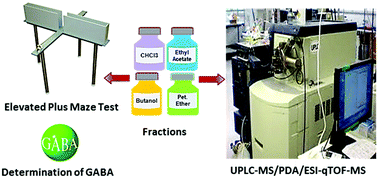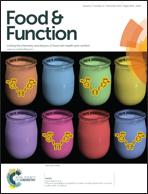Mechanistic evidence of Passiflora edulis (Passifloraceae) anxiolytic activity in relation to its metabolite fingerprint as revealed via LC-MS and chemometrics†
Abstract
Passiflora edulis Sims F. flavicarpa along with several other plants belonging to the genus Passiflora have been reported as sedatives and for treatment or prevention of central disorders. This study evaluated the anxiolytic effect of P. edulis ethanol extract and its fractions (viz. chloroform, ethyl acetate and butanol) using the elevated plus-maze model of anxiety and assessment of γ-aminobutyric acid levels. The results revealed that butanol and chloroform extracts exhibit the strongest effect followed by ethyl acetate suggesting that a combination of different classes of metabolites is likely to mediate for P. edulis anxiolytic effect in these fractions. To further pinpoint bioactive agents in fractions, ultra-performance liquid chromatography (UPLC) coupled to high resolution qTOF-MS was used for secondary metabolite profiling. A total of 65 metabolites were characterized including O-flavonoids, C-flavonoids, cyanogenic glycosides and fatty acids. Harman type alkaloids found in P. incarnata were not detected in P. edulis ethanol extract or any of its fractions suggesting that they do not mediate for its CNS modulating effects. Multivariate data analysis (PCA) was further applied to identify metabolite markers for fractions and revealed that enrichment of C-glycoside type flavonoids in chloroform/ethyl acetate fractions versus the exclusive presence of cyanogenic glycosides in its butanol fraction.


 Please wait while we load your content...
Please wait while we load your content...